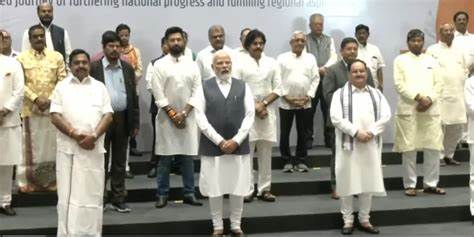The political landscape for Prime Minister Narendra Modi’s third term, dubbed Modi 3.0, is fraught with challenges, particularly due to the absence of a clear majority. Prime Minister Narendra Modi’s third term, known as Modi 3.0, faces significant challenges. “Coalition hinders Modi 3.0” as it navigates governance and policy implementation amidst a fragmented mandate in India.. Economic reforms and infrastructure development initiatives may face delays or compromises, impacting India’s growth prospects. This article explores the hurdles and implications of a fragmented mandate, analyzing how it could impact India’s governance, policy implementation, and political stability.
The Election Outcome
The 2024 general elections have delivered a mixed verdict. While the BJP remains the single largest party, it fell short of the majority mark. This outcome necessitates coalition politics, a terrain often marked by compromises and instability. The BJP’s inability to secure a clear majority is a significant shift from its previous electoral performances, where Modi’s leadership and the party’s robust campaign strategies ensured decisive victories.
Coalition Complications
Without a clear majority, the BJP must now navigate the complexities of coalition politics. Forming alliances with regional parties is essential, but it comes with the challenge of managing diverse and sometimes conflicting interests. These political dynamics can slow down decision-making processes and complicate the implementation of the party’s agenda. The necessity to accommodate coalition partners’ demands could dilute the BJP’s policy priorities and lead to frequent political negotiations, impacting governance efficiency.
Legislative Gridlock
A fragmented mandate often results in legislative gridlock. Passing key legislation requires broader consensus, which can be difficult to achieve in a coalition setup. Important bills and reforms may face delays or rejections, stalling the government’s progress on critical issues such as economic reforms, social policies, and infrastructure development. The frequent need to appease coalition partners might also result in watered-down legislation that fails to fully address the nation’s needs.
Support Independent Journalism? Keep us live.
Economic Implications
Political instability and legislative gridlock can have adverse effects on the economy. Investors prefer stable governments that can ensure policy continuity and a conducive business environment. The lack of a clear majority raises concerns about policy predictability, which can affect investor confidence and slow economic growth. Additionally, economic reforms may take longer to materialize, impacting India’s long-term growth prospects.
Governance Challenges
Governance under a coalition government is inherently challenging. Coordination between different ministries, led by leaders from various coalition parties, can be problematic. This fragmentation can lead to inefficiencies and conflicts, hindering effective governance. The focus might shift from long-term developmental goals to short-term political gains, further complicating governance.
Impact on Modi’s Leadership
Modi’s leadership, which has been characterized by strong central control and decisive decision-making, will be tested in this new political scenario. The need for consensus and coalition management could constrain his ability to push through his agenda with the same vigor as before. Maintaining the support of coalition partners while staying true to the BJP’s core policies will require adept political maneuvering.
Looking Ahead
The road ahead for Modi 3.0 is undoubtedly challenging. The lack of a clear majority forces a reliance on coalition politics, which can impede governance and policy implementation. However, it also offers an opportunity for the BJP to demonstrate its ability to lead a diverse coalition and address the nation’s issues through inclusive and collaborative governance. In conclusion, the effectiveness of Modi 3.0’s governance hinges on adeptly managing coalition dynamics. “Coalition hinders Modi 3.0” encapsulates the ongoing challenges in achieving cohesive policy implementation and political stability in India.


Comments are closed.